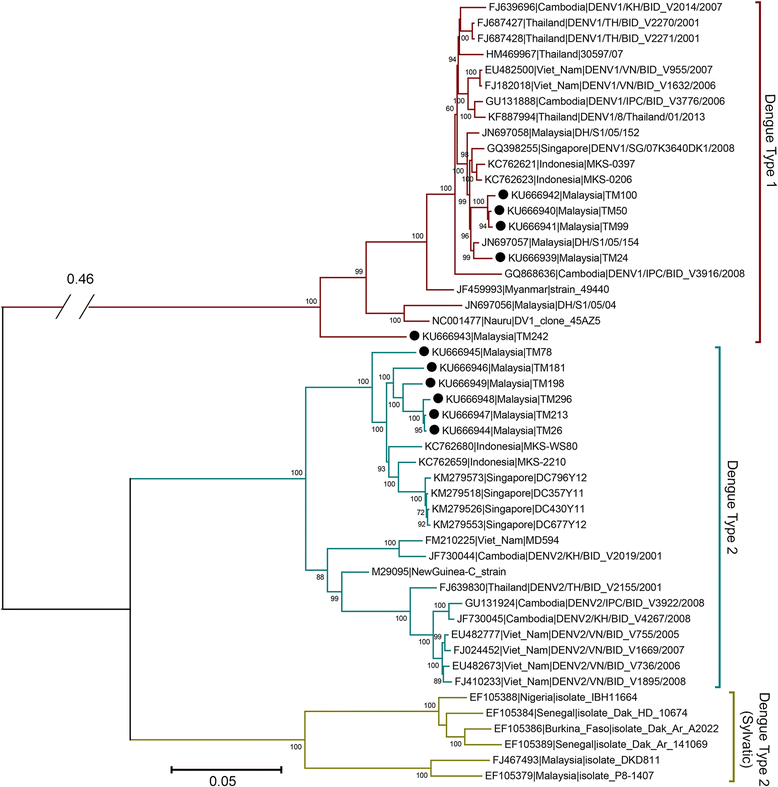Impact of dengue virus (DENV) co-infection on clinical manifestations, disease severity and laboratory parameters
- PMID: 27514512
- PMCID: PMC4982428
- DOI: 10.1186/s12879-016-1731-8
Impact of dengue virus (DENV) co-infection on clinical manifestations, disease severity and laboratory parameters
Abstract
Background: The co-circulation of 4 DENV serotypes in geographically expanding area, has resulted in increasing occurrence of DENV co-infections. However, studies assessing the clinical impact of DENV co-infections have been scarce and have involved small number of patients. This study explores the impact of DENV co-infection on clinical manifestations and laboratory parameters.
Methods: This retrospective study involved consecutive hospitalized patients with non-structural protein 1 (NS1) antigen positivity during an outbreak (Jan to April 2014). Multiplex RT-PCR was performed directly on NS1 positive serum samples to detect and determine the DENV serotypes. All PCR-positive serum samples were inoculated onto C6/36 cells. Multiplex PCR was repeated on the supernatant of the first blind passage of the serum-infected cells. Random samples of supernatant from the first passage of C6/36 infected cells were subjected to whole genome sequencing. Clinical and laboratory variables were compared between patients with and without DENV co-infections.
Results: Of the 290 NS1 positive serum samples, 280 were PCR positive for DENV. Medical notes of 262 patients were available for analysis. All 4 DENV serotypes were identified. Of the 262 patients, forty patients (15.3 %) had DENV co-infections: DENV-1/DENV-2(85 %), DENV-1/DENV-3 (12.5 %) and DENV-2/DENV-3 (2.5 %). Another 222 patients (84.7 %) were infected with single DENV serotype (mono-infection), with DENV- 1 (76.6 %) and DENV- 2 (19.8 %) predominating. Secondary dengue infections occurred in 31.3 % patients. Whole genome sequences of random samples representing DENV-1 and DENV-2 showed heterogeneity amongst the DENVs. Multivariate analysis revealed that pleural effusion and the presence of warning signs were significantly higher in the co-infected group, both in the overall and subgroup analysis. Diarrhoea was negatively associated with co-infection. Additionally, DENV-2 co-infected patients had higher frequency of patients with severe thrombocytopenia (platelet count < 50,000/mm(3)), whereas DENV-2 mono-infections presented more commonly with myalgia. Elevated creatinine levels were more frequent amongst the co-infected patients in univariate analysis. Haemoconcentration and haemorrhagic manifestations were not higher amongst the co-infected patients. Serotypes associated with severe dengue were: DENV-1 (n = 9), DENV-2 (n = 1), DENV-3 (n = 1) in mono-infected patients and DENV-1/DENV-2 (n = 5) and DENV-1/DENV-3 (n = 1) amongst the co-infected patients.
Conclusion: DENV co-infections are not uncommon in a hyperendemic region and co-infected patients are skewed towards more severe clinical manifestations compared to mono-infected patients.
Keywords: Clinical manifestations; Co-infection; DENV; Dengue virus; RT-PCR; Serotype.
Figures

Similar articles
-
Clinical manifestations of dengue in relation to dengue serotype and genotype in Malaysia: A retrospective observational study.PLoS Negl Trop Dis. 2018 Sep 18;12(9):e0006817. doi: 10.1371/journal.pntd.0006817. eCollection 2018 Sep. PLoS Negl Trop Dis. 2018. PMID: 30226880 Free PMC article.
-
Episodes of the epidemiological factors correlated with prevailing viral infections with dengue virus and molecular characterization of serotype-specific dengue virus circulation in eastern India.Infect Genet Evol. 2018 Mar;58:40-49. doi: 10.1016/j.meegid.2017.12.005. Epub 2017 Dec 13. Infect Genet Evol. 2018. PMID: 29247706
-
Co-infection between Zika and different Dengue serotypes during DENV outbreak in Brazil.J Infect Public Health. 2019 Mar-Apr;12(2):178-181. doi: 10.1016/j.jiph.2018.09.007. Epub 2018 Oct 6. J Infect Public Health. 2019. PMID: 30301701
-
The Dengue virus in Nepal: gaps in diagnosis and surveillance.Ann Clin Microbiol Antimicrob. 2018 Jul 16;17(1):32. doi: 10.1186/s12941-018-0284-7. Ann Clin Microbiol Antimicrob. 2018. PMID: 30008269 Free PMC article. Review.
-
Concordance of dengue viral load with disease severity and different clinical manifestations: A systematic review and meta-analysis.Indian J Med Microbiol. 2025 May-Jun;55:100852. doi: 10.1016/j.ijmmb.2025.100852. Epub 2025 Apr 15. Indian J Med Microbiol. 2025. PMID: 40239895
Cited by
-
The Innate Immune Response in DENV- and CHIKV-Infected Placentas and the Consequences for the Fetuses: A Minireview.Viruses. 2023 Sep 6;15(9):1885. doi: 10.3390/v15091885. Viruses. 2023. PMID: 37766291 Free PMC article. Review.
-
DengueSeq: A pan-serotype whole genome amplicon sequencing protocol for dengue virus.medRxiv [Preprint]. 2023 Oct 13:2023.10.13.23296997. doi: 10.1101/2023.10.13.23296997. medRxiv. 2023. Update in: BMC Genomics. 2024 May 1;25(1):433. doi: 10.1186/s12864-024-10350-x. PMID: 37873191 Free PMC article. Updated. Preprint.
-
Concurrent dengue infections: Epidemiology & clinical implications.Indian J Med Res. 2021 May;154(5):669-679. doi: 10.4103/ijmr.IJMR_1219_18. Indian J Med Res. 2021. PMID: 35532585 Free PMC article. Review.
-
Safety and costs of blood transfusion practices in dengue cases in Brazil.PLoS One. 2019 Jul 8;14(7):e0219287. doi: 10.1371/journal.pone.0219287. eCollection 2019. PLoS One. 2019. PMID: 31283788 Free PMC article.
-
Clinical and laboratory comparison of severe (Group B and C) Dengue cases with molecular characterization from 2019 epidemics in Dhaka, Bangladesh.PLoS Negl Trop Dis. 2024 Nov 25;18(11):e0012686. doi: 10.1371/journal.pntd.0012686. eCollection 2024 Nov. PLoS Negl Trop Dis. 2024. PMID: 39585911 Free PMC article.
References
-
- World Health Organization. Dengue and severe dengue. 2016. http://www.who.int/mediacentre/factsheets/fs117/en/. Accessed 9 May 2016.
-
- World Health Organization . Dengue haemorrhagic fever: diagnosis, treatment, prevention, and control. 2. Geneva: World Health Organization; 1997.
-
- WHO . Dengue guidelines for diagnosis, treatment, prevention and control. 3. Geneva: World Health Organization; 2009. - PubMed
MeSH terms
Substances
LinkOut - more resources
Full Text Sources
Other Literature Sources
Medical
Research Materials
Miscellaneous

